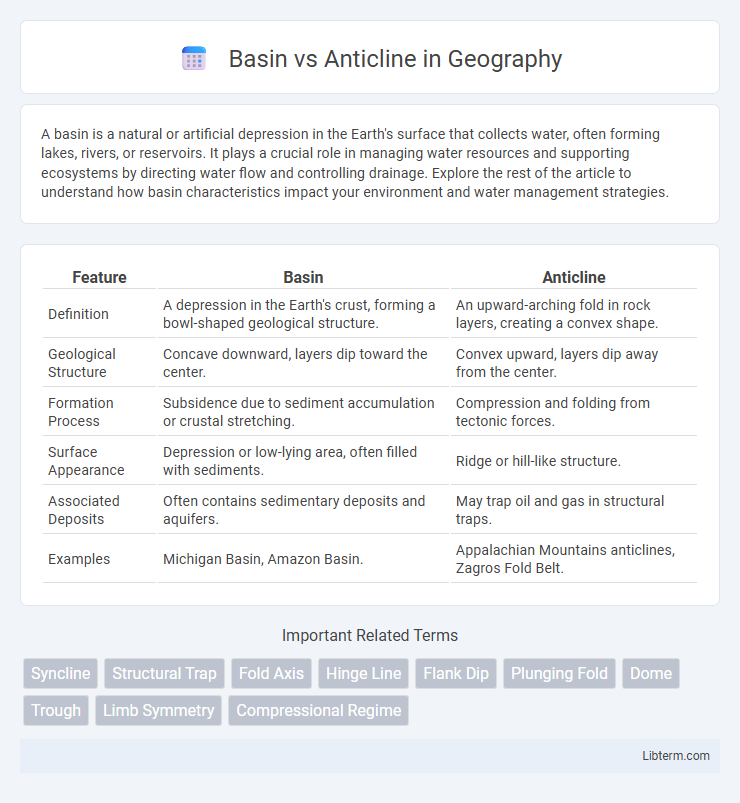A basin is a natural or artificial depression in the Earth's surface that collects water, often forming lakes, rivers, or reservoirs. It plays a crucial role in managing water resources and supporting ecosystems by directing water flow and controlling drainage. Explore the rest of the article to understand how basin characteristics impact your environment and water management strategies.
Table of Comparison
| Feature | Basin | Anticline |
|---|---|---|
| Definition | A depression in the Earth's crust, forming a bowl-shaped geological structure. | An upward-arching fold in rock layers, creating a convex shape. |
| Geological Structure | Concave downward, layers dip toward the center. | Convex upward, layers dip away from the center. |
| Formation Process | Subsidence due to sediment accumulation or crustal stretching. | Compression and folding from tectonic forces. |
| Surface Appearance | Depression or low-lying area, often filled with sediments. | Ridge or hill-like structure. |
| Associated Deposits | Often contains sedimentary deposits and aquifers. | May trap oil and gas in structural traps. |
| Examples | Michigan Basin, Amazon Basin. | Appalachian Mountains anticlines, Zagros Fold Belt. |
Introduction to Basins and Anticlines
Basins are large-scale geological depressions where sediment accumulates, often forming layered rock sequences that provide important records of Earth's history. Anticlines are upward-arching folds in rock layers, typically serving as traps for oil and natural gas due to their structural geometry. Understanding the formation and characteristics of basins and anticlines is crucial for hydrocarbon exploration and geological mapping.
Geological Definition of a Basin
A basin is a geological depression or hollow where sediments accumulate, often characterized by a synclinal structure with layers dipping inward toward the center. In contrast, an anticline is an arch-like fold with layers dipping away from the crest. Basins serve as significant sedimentary environments and hydrocarbon traps, whereas anticlines are primarily structural traps in petroleum geology.
Geological Definition of an Anticline
An anticline is a type of fold characterized by an arch-like shape with its oldest rock layers at the core and limbs dipping away from the center. It forms through compressional forces that deform sedimentary strata, creating a convex-upward structure significant in petroleum geology as potential hydrocarbon traps. Basins contrast with anticlines by being downward-curving depressions where younger rocks accumulate, often hosting sedimentary deposits and aquifers.
Formation Processes of Basins
Basins form primarily through processes such as subsidence caused by tectonic plate movements, crustal stretching, and sediment loading. These depressions accumulate sediments over time, creating thick sedimentary sequences influenced by gravitational and thermal factors. In contrast, anticlines develop from compressional forces that fold rock strata upwards, creating arch-like structures.
Formation Processes of Anticlines
Anticlines form through compressional forces that cause rock layers to buckle and arch upwards, typically during tectonic plate collisions. These geological structures are characterized by their convex-upward shape, where the oldest rock layers reside at the core of the fold. Understanding the formation of anticlines helps in identifying potential oil and gas reservoirs, as these folds often create traps for hydrocarbons.
Key Structural Differences between Basins and Anticlines
Basins are geological structures characterized by a downward concave shape where rock layers dip inward from all directions, forming a bowl-like depression often associated with sediment accumulation. Anticlines are upward-arching folds where rock strata tilt away from the central crest, typically forming arch-shaped ridges with the oldest rocks at the core. Key structural differences include the direction of layer dip--basins dip inward while anticlines dip outward--and the relative age of exposed rocks, with basins exposing younger strata centrally and anticlines exposing older strata at their core.
Role in Natural Resource Accumulation
Basins serve as prime locations for the accumulation of sedimentary deposits, including hydrocarbons, due to their ability to trap organic material and allow for thick sediment build-up over time. Anticlines, with their arch-shaped folds, act as structural traps that can concentrate oil and natural gas migrating upward, preventing their escape and thus enabling economically viable extraction. The combination of sedimentary basins providing source rocks and anticlines functioning as traps makes them critical features in petroleum geology and natural resource accumulation.
Identification and Mapping Techniques
Basin identification and mapping rely heavily on seismic reflection data to reveal subsurface synclinal structures characterized by downward warping layers, while anticline mapping focuses on upward-arching folds identified through structural contour maps and seismic profiles that highlight crest lines and fold axes. Well-log correlation and gravity surveys assist in distinguishing basins by their sedimentary thickness variations and anticlines by their distinctive density contrasts. Remote sensing techniques, such as satellite imagery and digital elevation models (DEMs), support surface expression analysis, complementing geophysical data for comprehensive basin and anticline structural mapping.
Significance in Tectonic Settings
Basins and anticlines serve as critical indicators in tectonic settings, revealing the nature of crustal deformation and sedimentary processes. Basins, often formed through extensional tectonics, accumulate thick sedimentary sequences that record subsidence and can host significant hydrocarbon reserves. Anticlines represent compressional regimes where rock layers fold upward, frequently creating structural traps vital for oil and gas exploration.
Practical Applications in Geology and Industry
Basins serve as critical reservoirs for hydrocarbons due to their capacity to accumulate thick sedimentary layers, making them prime targets for oil and gas exploration. Anticlines act as structural traps where oil and natural gas migrate and accumulate, enabling efficient extraction in petroleum geology. Understanding the formation and characteristics of both basins and anticlines guides resource management, groundwater studies, and mineral exploration in the industry.
Basin Infographic

 libterm.com
libterm.com